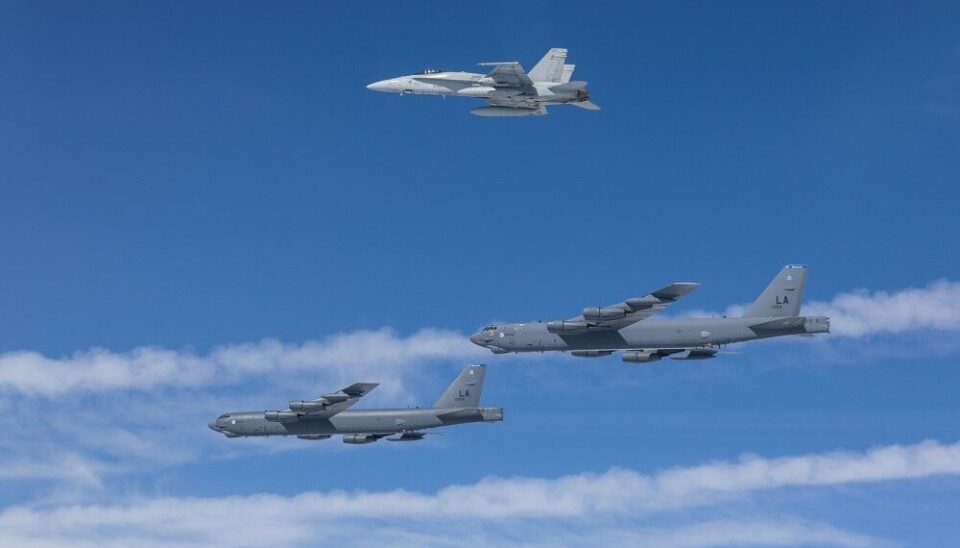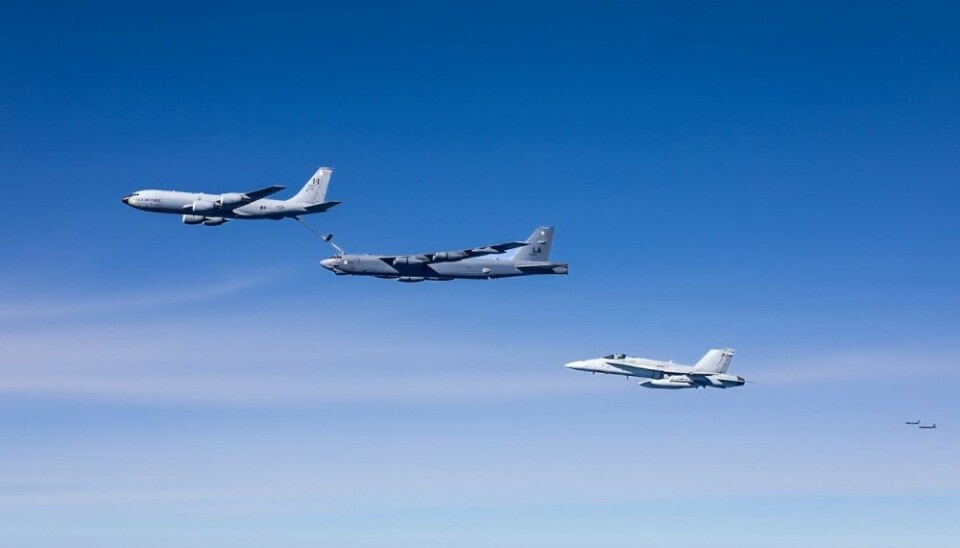
B-52 on first time mission over northern Finland
A pair of B-52 strategic bombers that came in over Finland from Norwegian air space made a first-ever flight in the skies above Lapland near the Lake Inari Sunday morning.
The two strategic bombers crossed the border into Finland from Norway’s northern region. Over Lapland, they were met by three U.S. Air Force tankers and Finnish fighter jets.
“Today, Finland has implemented cooperation with the strategic bombers of the United States in the territory of Finland,” the country’s defense minister Antti Häkkänen said on X.
“It is a normal cooperation carried out in the territory of a NATO member country and it demonstrate the basic pillar of common defense and deterrence,” Häkkänen said.
Suomi on tänään toteuttanut yhteistoimintaa Yhdysvaltojen strategisten pommikoneiden kanssa Suomen alueella. Kyse on normaalista Naton jäsenmaan alueella toteutettavasta yhteistoiminnasta sekä yhteisen puolustuksen peruspilarin, pelotteen ja puolustuksen osoittamisesta. (1/2)
But two B-52 strategic bombers over northern Finland is far from normal. It has never happened before and shows the fundamental change in geopolitics following Russia’s full-scale invasion of Ukraine in February 2022.
As a result of the war, Finland joined NATO in April 2023 and said there will be no geographical restrictions on where NATO-partners could cooperate within the country’s territory.
Defense analyst with the Norwegian Institute of International Affairs (NUPI), Per Erik Solli, is not surprised.
“This development is a natural evolution in a process gradually strengthening regional and multinational deterrence,” Solli says to the Barents Observer.
Solli is a former F-16 fighter jet pilot in the Norwegian Air Force and has followed the strategic changes in both air- and naval power inside the Arctic Circle in recent years. He has published a longer OpEd in the Barents Observer about national and NATO changes seen after February 2022.
Close to the Kola Peninsula
The B-52 bombers were in transit from the United States to deployment in Romania, Europe.
North in Lapland is about as close to the Kola Peninsula as it is possible to get from the southwest. Saariselkä, where the plane was met by the U.S. Air Force tankers, is some 220 kilometers inside the Arctic Circle. But before that, the plane had been on the north side of the Kola Peninsula, over the Barents Sea.
On Sunday it was clear skies all over northernmost Finland and Russia’s northwest corner. From cockpit, the pilots could see deep into the Kola Peninsula where Russia has its ballistic missile submarines along the coast to the Barents Sea.
In distance, the crew of the B-52 could also see the Olenya airfield from where Russia’s Tu-95MS bombers use to take off when flying missions to bomb civilian infrastructure in Ukraine.
The American strategic bombers aircraft entered Finland from Norway, the Finnish Air Force informs in a short statement.
Spokesperson Henrik Omtvedt Jenssen with the Norwegian Joint Headquarters confirms to the Barents Observer that the planes crossed over Finnmark.
“They were transiting Norwegian airspace and continued into Finland,” Jenssen says.
Norway did not provide fighter jet escort for the American planes while in Norwegian airspace, Jenssen informs.
Barents Sea
Russia’s defense ministry said to state-controlled information agency Interfax that the American bombers first approached Russian air space over the Barents Sea. The country’s Air Force scrambled MiG-31 and MiG-29 fighters jets from the Kola Peninsula to meet the American planes.
“When Russian fighters approached, American strategic bombers made a U-turn from the state border of the Russian Federation,” the defense ministry said.
NATO, though, rejects the Russian claims. “The U.S. aircraft did not change course due to the intercept and continued along their scheduled flight plan without incident,” a statement published by the Alliance points out. This happened around 08 am CET.
Since it is unlikely that the Russian MiGs intercepted the American bombers west outside Finnmark, the planes most likely came south over the Arctic towards the maritime border areas between Norway and Russia and then turned a pre-planed course southwest.
The pair of B-52 entered Norwegian air space into Finnmark region and from there made a southbound flight into Finnish Lapland.
In Finland, they passed over Saariselkä around 10 am local time. The mission on July 21 is the closest U.S. B-52 bombers ever has half-circumnavigated the Kola Peninsula. It is also the closest such strategic bombers have been to Russia’s strategical important Olenya air field.
The B-52 planes were met by three U.S. Air Force tankers; two KC-135 and one KC-46, over northern Finland. The bombers were escorted inside Finland by F/A-18 from the Finnish Air Force.

“Cooperation with the flight detachment improves interoperability between the allies,” the Air Force statement says.
In February this year, a pair of U,S. Air Force supersonic B-1B bombers were deployed to Kallax air base in Luleå, northern Sweden. The country officially became a full member of NATO on March 7th.
Norway restrictions
Norway, which all since 1949 has had restrictions on NATO activities in a buffer zone close to the Russian border, do not allow B-52 or any American surveillance flights east of the Porsanger fjord in Finnmark.
When three B-52 planes in May 2021 flew a mission north of the Kola Peninsula, they were not allowed inside Norwegian airspace in the east Finnmark region.
Norwegian military spokesperson Henrik Omtvedt Jenssen was not willing on Sunday to detail where in the airspace over Finnmark the B-52 planes were flying on Sunday.
B-52 is the largest long-range strategic bomber in the US Air Force. It can carry a heavy load of air-launched cruise missiles. Some of the planes are also equipped to carry nuclear weapons, although such weapons are not loaded on exercise flights like the one over Finland on Sunday.















